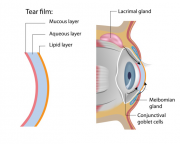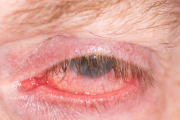Contents |
Dry Eye Symptoms: Meibomian Gland Dysfunction
Meibomian gland dysfunction (MGD) is the term used for a family of eyelid margin disorders that cause symptoms such as redness, swelling, itching or burning, dryness, crusty lid margins, grittiness, and even the eventual loss of eyelashes.
MGD is also known as blepharitis, meibomeitis, meibomitis, blepharoconjunctivitis and several other terms. In some studies, blepharitis is considered to be caused by MGD. Currently, there are efforts being made to classify this entire range of conditions in order to reduce confusion, not only between patients but between eyecare practitioners. The important issue is not the exact naming or exact classification, but to evaluate basic causes and effective treatments.
MGD does not often cause long-term vision loss but it can complicate dry eye symptoms arising from other sources and also make ocular surgery somewhat problematic, because of the likelihood of infection and/or inflammation of the tissues. Additionally, this issue causes mild to severe discomfort and disruption in daily living.
Normal Meibomian Gland Function
It is helpful to understand normal conditions in and around the eyes and what goes wrong to cause signs and symptoms of MGD.
Natural tears are composed of three main layers which must be present and in proper balance to keep the eye lubricated. First, about 90% of the tear layer is composed of what most would call salt water, known as the aqueous. Half of the remaining tear layer is made up of a layer of lipids, which keep the moisture from evaporating too quickly, and the rest consists of a substance called meibum, sometimes referred to as mucin, which acts as a base for the other two tear components. Meibum keeps the tear layer adhered to the surface of the eye and is important in keeping the tear layer smooth and regular with each blink.
Meibum is produced by the meibomian glands located in the eyelids, upper and lower, with ducts opening just behind the line of the eyelashes. Dysfunction of these very important glands is thought to be the leading cause of dry eye disease and the troublesome variety of symptoms related to disruption of the tear layers.
What Goes Wrong
MGD is generally thought of as being one of two types, characterized by either too much meibum or not enough. When the makeup of the tear layer is altered, dry eye symptoms result in irritation and inflammation of the surface of the eye.
MGD can also be considered as a chronic, ongoing problem or an acute issue caused by a short-term infection or inflammation which can usually be treated more easily. In the ongoing, chronic type of MGD, the glands must be evaluated and their secretions assessed as to quantity and quality. Increasing severity of MGD is mirrored by increased severity of dry eye symptoms.
Associated with MGD are acute and chronic forms of gland inflammation which may be called a stye, hordeolum or chalazion. It is possible for more than one of these to occur simultaneously. The term stye, or sty is an older, more general term for infection, inflammation and/or impaction of one or more meibomian glands. A hordeolum is an acute, active infection which causes localized pain, swelling and redness of the gland, while a chalazion is the chronic form in which the contents of the gland harden and the gland no longer functions. A hordeolum or chalazion can be said to be internal, on the inner surface of the lid, or external, with most of the inflammation and swelling on the outer surface. These acute and chronic conditions are usually caused by infection.
Some systemic diseases and conditions can cause or contribute to MGD; acne rosacea or other inflammatory or autoimmune diseases. Studies show that almost 60% of acne rosacea patients also experience related symptoms such as blepharitis and unstable tear film with dry eye symptoms, blepharitis and conjunctivitis.
Dry eye symptoms may include all of these, separately or in combination, at various levels of discomfort and disruption:
- Redness
- Swelling of lid margins
- Itching
- Burning
- Foreign body sensation
- Dryness sensation
- Crusty lid margins
- Grittiness
- Eventual loss of eyelashes
- Loss of pigment in lashes if/when they grow back
- Light sensitivity or photophobia
- Uneven thickness of eyelids
- Limitations of usual activities
Testing and Evaluation
During a vision examination, the eyecare practitioner may simply try to squeeze some of the glandular material from one or more meibomian glands, and assess its quality as well as quantity. Using a fingertip or cotton swab, gentle pressure is applied to the lids and its contents viewed. Secretions may range from mild thickening and cloudiness to severe thickening similar to that of toothpaste, or complete closure of the gland openings along the lid margin so that no meibum can come out at all. Using the slit lamp biomicroscope, the lid margins and their hygiene will be evaluated. Normal eyelids should be of a consistent thickness without swelling or redness. The gland openings should be visible and not blocked with hardened meibum; the eyelashes should be clean and without scales or other debris around the base of each lash.
Stains may be added to the tear film, making it much easier to see how it spreads over the ocular surface, how long it takes for dry spots to form. Damaged tissue can be stained for evaluation of the extent of damage to the eye from lack of meibum.
The Demodex Mite
A particular type of blepharitis and MGD is caused by sensitivity to the demodex mite, which infests the follicles of individual eyelashes. For this type of blepharitis/MGD, the best treatment has been tea tree oil applied to the lids. Because this can be messy and inconvenient, there is now a product that contains the active ingredient present in tea tree oil, which specifically treats mite-caused MGD.
Demodex mites are very common; it is estimated that about 85% of the population at age 60 will have demodex in and around the eyelash follicles on the edge of the eyelid; at age 70, the percentage reaches almost 100%. The presence of demodex mites is not a sign of poor hygiene or any failure of the patient; they are everywhere, in a way, they are similar to dust mites that live everywhere about us; like some people are allergic to dust mites, some individuals have a higher sensitivity to their presence than others, which is the cause of the problem.
For more specific information about demodex, please see the article titled “Dry Eye Symptoms: Demodex” in this section.
Treatment
Improving eyelid hygiene is the first line of treatment for MGD is to using lid scrubs at home at least twice a day with a clean washcloth or cotton swab and either baby shampoo or a commercial eyelid cleaner. Hot compresses twice a day for at least four minutes each time, accompanied by firm lid massage in an effort to warm the contents of the meibomian glands and help remove some of the unsecreted material are very helpful in almost all cases.
Antibiotic drops or oral medications may be prescribed in the case of infection,. Frequent use of unpreserved lubricant drops can help decrease symptoms. Recently, liposomal spray has been useful in renewing the lipid layer of the tears and helps reduce evaporation. Anti-inflammatory agents for dry eye can also be considered. Adding omega-3 fatty acids to the diet has been shown to be helpful as well.
The BlephEx is used in the office by eyecare practitioners, to provide thorough cleaning of the lid margins and lash follicles. The tool is equipped with a rotating head which can move in either direction. A sterile lid cleaner is applied to a new sponge tip and the lids are cleaned with the tool rotating in one direction, then the other, so as to provide cleaning from both sides of each individual lash and gland opening. Skin flakes, oils, scales and other debris can be easily cleaned from the margins of the eyelids using the BlephEx. It is well-tolerated, not painful and effective in providing improved comfort almost immediately.
Tea tree oil, or a commercial product containing the active ingredient, is the treatment of choice for demodex mites.
Omega-3 fatty acids added to the diet have been shown to improve dry eye symptoms. Polyunsaturated omega-3s can be found in certain fish and in flax seed, as well as in supplements of fish oils or flax seed oils.
Other treatments in individuals with more than one cause underlying their dry eye symptoms, ocular lubricants, topical cyclosporine, topical steroids, blinking exercises and improved lid hygiene are all helpful in reducing discomfort.
A new therapy that may hold promise is the use of autologous eye drops; In a recent study, blood was drawn from each patient and centrifuged for removal of red and white blood cells. The remaining serum was filtered and diluted to 50% using sterile saline by a compounding pharmacy. The resulting eye drops were found to be both safe and more effective in reducing symptoms, especially in patients with severe dry eye symptoms that were not responding well to conventional treatment.
Bad News, Good News
Control of dry eye symptoms is important to the future eye health of individuals, particularly in the case of people who may need some form of ocular surgery in the future, such as cataract removal. Inflammation, infection and eyelid disease all contribute to complications later.
Bad news: it is important to know that there is no sure “cure” for the symptoms of dry eyes, and that routine, ongoing therapies may be necessary for long-term control of a troublesome issue.
Good news: the reward for diligent compliance with routine treatments over the long term is much improved comfort, better eye health and better vision.
For more information on Dry Eye Symptoms, please see the articles titled “Dry Eye Symptoms: Introduction,” and “Dry Eye Symptoms: Causes and Treatments.”








